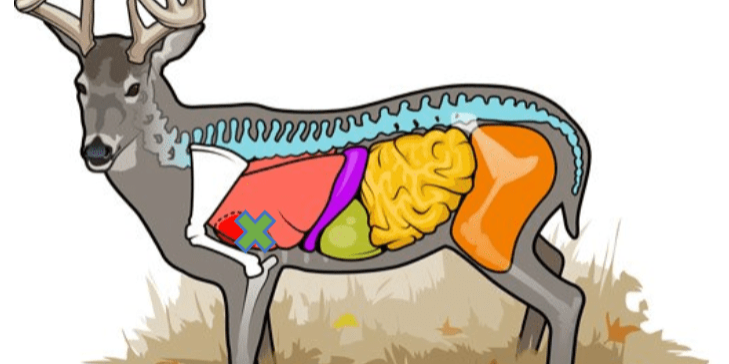Summer is in the air! We as whitetail bowhunters are spending our days planning out our food plots, prepping mineral stations, figuring out our new stand locations, and hopefully starting to shoot the bows!
As Bowhunters, we are seemingly never satisfied with our setups; always finding ourselves chasing the next fad or claiming we are reverting back to the old “tried and true” method – nevertheless, always changing something!
I can relate to the excitement of chasing the fads. After a few years of changing setups, getting new bows, thinner arrows, thicker arrows, fixed broadheads, expandable heads, etc. I came to the realization that in all this change, the only consistent to a fast, ethical kill, is shot placement.
Before I continue, I must preface this article. I am not an expert archer. I am an average Joe, who loves to hunt whitetail deer. My goal is to shed some light on a topic that helped me become a more successful bow hunter, and hopefully help the reader to increase their harvest success, as well.
My setup consists of a Mathews Heli-M that is 10 years old and set at 62lb draw (clearly not a speed freak). I shoot carbon express 250 arrows, and they are typically tipped with a Rage broadhead. I shoot this setup not because I believe it is the best on the market – I am fairly certain it isn’t – but because I am confident with it, and I shoot it well.
As I gained more confidence with my equipment, my focus shifted to fanatically studying the deer’s anatomy. This translated to re-analyzing my aiming point on a whitetail, specifically for bow shots. The old adage “put it behind the shoulder” works well with a slug gun or rifle, but with a bow – we are playing a game of inches. Aiming point is crucial to consistent success.
Before we fully dive into the aiming point, let’s look into some common “NEEDS” that many bowhunters feel are needed to increase their successful harvest rate.
I NEED SPEED:
Speed is awesome and everyone likes watching a bow shoot lasers! My suggestion is to make sure you are not setting your draw weight too high or arrow weight too light. You want to comfortably draw, hold, and maneuver in a tree stand in cold temperatures. If you cannot do this – reduce the draw weight and give up a little speed. Be cognizant of arrow weight and to not to give up too much weight in an effort to solely gain speed – we want to kill deer, not just foam.
My setup is far from fast but I am getting consistent pass-throughs on whitetails. My average stand setups are for shots 30 yards or less, often killing them at 10 yards. If you want speed because you are shooting much farther distances, hunting out West, etc., then adjust your setup to meet your goals accordingly.
I NEED MOMENTUM:
Similar to the above, this is a fair and valid need. I am not going to get into the engineering behind why speed is better vs. momentum or visa-versa. I will point out that if your fear lies in hitting the shoulder, and you feel that a heavy setup will get you more comfortable with shooting toward that part of the deer, by all means, build that heavy setup. On a heavier setup, just be sure you are not building something that is too heavy that won’t allow you to shoot your desired range.
For myself, I like to be comfortable to shoot 30 yards on a live animal. My setup shoots flat at 30 and I don’t fear arrow drop-off. If you are a bow hunter who likes to shoot, 40, 50, 60 yards at a live animal, you will want to note reaction times of a whitetail, as well as aiming points.
There are experts on both speed and momentum that build amazing arrow setups. If you are interested, take a look on YouTube to learn more.
You might be wondering, “why is he talking about speed vs. momentum in an anatomy and aiming point article?” It is because, over the past few months, I have had several conversations with friends who shared their frustrations with bowhunting shot successes, or lack thereof. To list a few specifics; fear of hitting shoulder, poor shots – they thought were great, liver shots, lost deer, and so on. These guys all wanted to build new setups that would help to alleviate these issues and increase their harvest success
rate. The new arrow build might not be needed; let’s dive into the anatomy and aiming point.
First off, there has been a lot of information pumped into the hunting world that talks about hitting a deer in the shoulder. I believe that much of this is causing more issues than it is helping.

You can see in the image above; the shoulder bone is FAR more forward and higher than one might expect. When looking at a live deer, it appears that the shoulder covers much of their vitals- that simply is not the case. The fear to avoid the shoulder often results in pulling the shots further back into the rib cage (liver). Although often fatal, this can also become a very tough track job. The green X is where I settle my pin. A shot from a tree stand will always hit slightly higher than where you are aiming,
depending on the angle of trajectory.

Image 2 is another image that is widely used and referenced all around the internet to exhibit a whitetails anatomy. As you might notice, the shoulder (again) is far higher in the chest cavity than often assumed. Leaving an open “>” shape below the shoulder and above the front leg.
To consistently find the same aiming point, I follow the front leg of a whitetail up to where it connects to the deer. I settle my pin slightly above that front leg and before I see the rib bones starting to curve down towards the bottom of the chest. This can also be described as the lower 1/3 of a whitetail. When my pin settles at this spot (green X on image above) I am nowhere near the shoulder blade. Using this aiming method, I have punched an arrow through that part of the chest cavity on many deer resulting in a fast and ethical heart or lung kill. I have also witnessed a significant increase in harvests from good friends and family of mine who have taken this focus on anatomy and aiming point seriously.
If you continue to hit deer in the liver or in the shoulder, you are either aiming far too high or back on the rib cage – often liver shots are occurring due to fear of hitting the shoulder, as we showed above that fear is not fully justified if your aiming point is correct. Although, the benefit of a heavier arrow is it will punch through the shoulder. This is especially useful if you “pull” a shot, which can happen to all of us! Alternatively, going through a deer faster in a bad location, I don’t see having much of an upside – so if speed is your goal, shot placement must not be overlooked.
So, in the end, slow down, settle the pin on the lower 1/3 and let the arrow punch through the rib cage!
If after reading this you still want to buy a new bow, arrows, or broadheads – go for it! I know I won’t shoot my bow forever and I look forward to eventually buying and building a new setup. I do know that once I get to that point, my aiming point will stay consistent with my new setups, as it is now.
All in all, I hope this is helpful for at least a few out there! I hope the next time you settle that pin on a whitetail, you kill fast, and may your freezers stay full!
One tree, plant, acre at a time –
Thanks for reading – AT
Albert Tomechko

